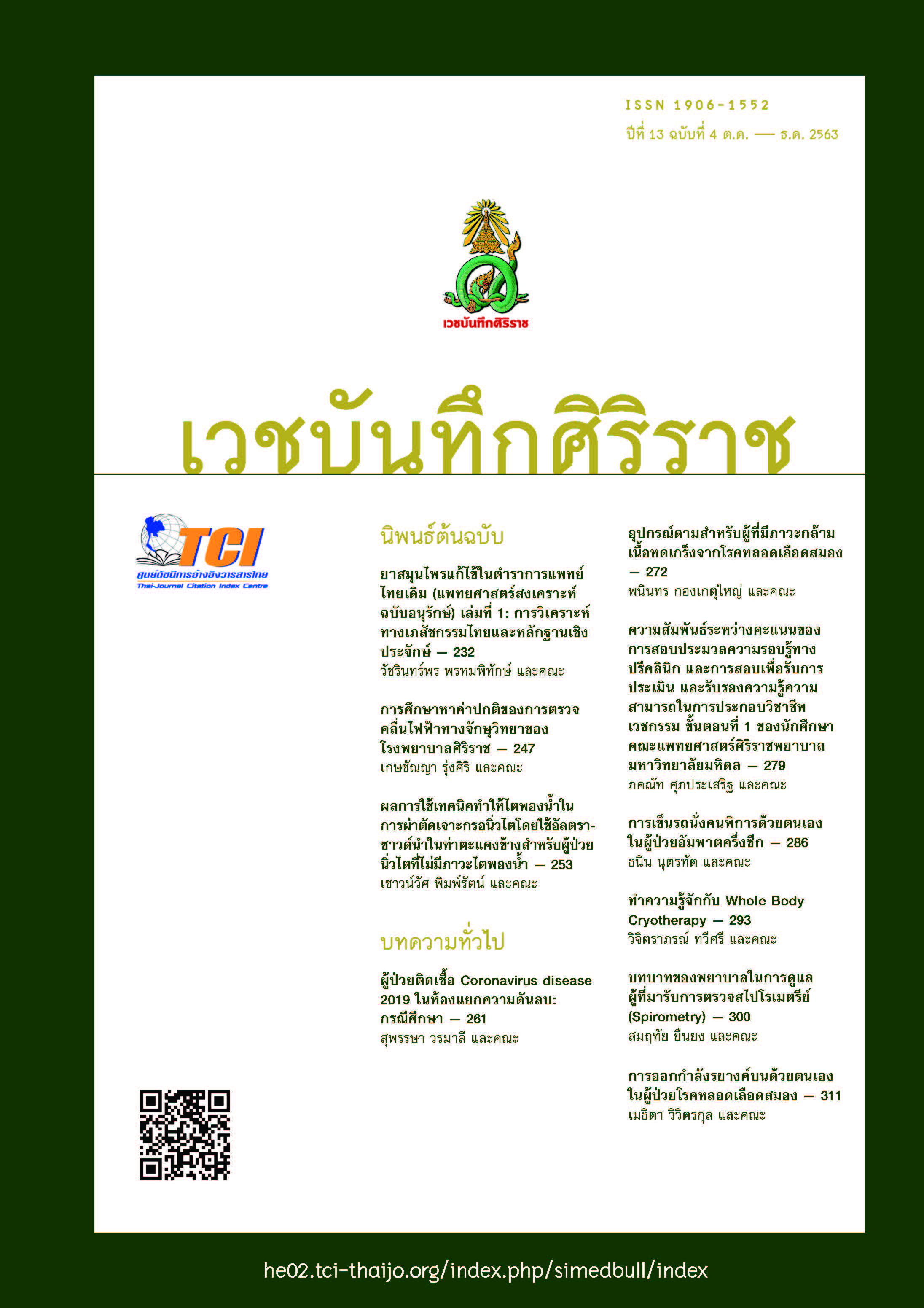Self - Propelling Wheelchair in Hemiplegic Patients
Main Article Content
Abstract
Hemiplegic patients usually have a mobility problem, which is part of the activity of daily living, so they will perform everyday activities more difficult, such as moving to take a shower. The wheelchair is one of the mobility assistive device to help these patients move at a short distance instead of walking.
There are many ways to use the wheelchair, and there are several types of wheelchairs specifically designed for different patients. This article presents techniques and methods using the wheelchair with only the unaffected hand and leg under supervision either before or after the test to ensure the safety. The patients, therefore, will feel confident with the methods and be able to practice these in daily life, reducing the dependence on other people, and also increasing the self-value of the patients.
Key word: Wheelchair, Hemiplegic patients, Self-propelling
Article Details
References
2. สำนักสารนิเทศ สำนักงานปลัดกระทรวงสาธารณสุข. กรมควบคุมโรครณรงค์วันอัมพาตโลก ปี 2562 [อินเทอร์เน็ต]. 2561 [เข้าถึงเมื่อ 2563 มีนาคม 10]. เข้าถึงได้จาก: https://pr.moph.go.th/?url=pr/detail/2/02/133619/
3. อลิสรา เตชะไพฑูรย์, วิษณุ กัมทรทิพย์, อรฉัตรโตษยานนท์. สมรรถภาพของผู้ป่วยอัมพาตจากโรคหลอดเลือดสมอง. เวชศาสตร์ฟื้นฟูสาร 2543; 9(3): 120-4.
4. Tsai KH, Lo HC. A novel design and clinical evaluation of a wheelchair for stroke patients. International Journal of Industrial Ergonomics. 2008; 38(3 - 4): 264 – 271.
5.ทศพร บรรยมาก. การประเมินการควบคุมการเคลื่อนไหว. ใน: พิศักดิ์ ชินชัย, บรรณาธิการ. กิจกรรมบำบัดสำหรับผู้มีปัญหาด้านระบบประสาท. พิมพ์ครั้งที่ 2. เชียงใหม่: ออเร้นท์กรุ๊ป เทคนิคดีไซน์; 2551. หน้า 1 - 33.
6. Barker D, Reid D, Cott C. Acceptance and Meanings of Wheelchair Use in Senior Stroke Survivors. American Journal of Occupational Therapy 2004; Volume 58:221-30.
7. วิสุทธินี เทือกทอง, วิษณุ กัมทรทิพย์, นิสากร คงศรี. ผลการลดเกร็งของแขนและมือในผู้ป่วยโรคหลอดเลือดสมองที่เกิดขึ้นทันทีหลังจากการเหยียดยืดเอ็นและกล้ามเนื้อแบบนิวโรฟิสิโอโลจิก เปรียบเทียบกับเหยียดยืดแบบออธ์โธปิดิกส์ : รายงานการวิจัยเบื้องต้น. เวชศาสตร์ฟื้นฟูสาร 2558; 25(1) 22-29.
8. Li s, Gerard E. Francisco, Zhou P. Post-stroke Hemiplegia Gait; New Perspective and Insights. Front. Physiol 2018; vol 9: 1-8.
9. Frost S, Mynes K, Noon J, Scheffler E, Stoeckle R. Wheelchair service training package: reference manual for participants Basic level. World Health Organization 2012.
10. DiGiovanni D, Marrion V, Nina H. One-Arm Drive Manual Wheelchair [Internet]. 2009 [cited 2020 March 10]. Available from:https://digitalcommons.wpi.edu/atrc-projects/9.
11. Jung H, Park G, Kim Y, Jung H. Development and evaluation of one-hand drivable manual wheelchair device for hemiplegic patients. Applied Ergonomics 2015;48:11-21.
12.พิศักดิ์ ชินชัย. ปัญหาด้านการมองเห็นและสายตา. ใน: พิศักดิ์ ชินชัย, บรรณาธิการ. กิจกรรมบำบัดสำหรับผู้มีปัญหาด้านระบบประสาท. พิมพ์ครั้งที่ 2. เชียงใหม่: ออเร้นท์กรุ๊ป เทคนิคดีไซน์; 2551. หน้า 97-100.
13. Stewart D. One Arm Drive Systems [Internet]. 2019 [cited 2020 March 10]. Available from:
https://mobilitybasics.ca/wheelchairs/onearmdrives.
14.Charbonneau R, Lee K, Thompson K. Manual Wheelchair Propulsion by People With Hemiplegia: Within-Participant Comparisons of Forward Versus Backward Techniques. Archives of Physical Medicine and Rehabilitation 2013; Volume 94:1707-13
15. Kirby RL, Swuste J, Dupuis DJ, MacLeod DA, Monroe R. The Wheelchair Skills Test: a pilot study of a new outcome measure. 2002; Arch Phys Med Rehabil 86(1): 10 -8.


